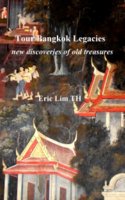| Back to Back Issues Page |
 |
|
Bangkok Travelbug November 14 Nang Yai Museum Wat Khanon Ratchaburi October 29, 2014 |
| Hello
Ratchaburi province Ratchaburi is an old province that dates back to the Dvaravati period 1,000 years ago. It’s about 100 km west of Bangkok on the banks of the Mae Klong River, a tributary of the famous River Kwai Yai. It’s on the border with Myanmar and the Tanaosi mountain range to the west forms a natural border. 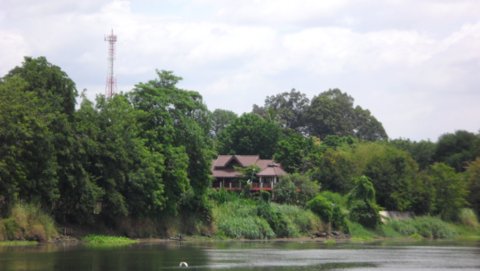
The Mae Klong River near Amphoe Photharam, Ratchaburi Tourist attractions like the Damneon Saduak floating market and the Rose Garden are in Ratchaburi. The province also has a wealth of natural and cultural treasures as we shall see. One of these cultural treasures is the Nang Yai shadow drama. Table of contents History of Nang Yai Nang Yai (big hide) is a shadow drama performed with almost life-size figures carved from cow hide and mounted on wooden frames. Each of these frames is carried by a performer and manoeuvred in a play that’s based on Ramakien, the Thai version of the Hindu Ramayana epics. 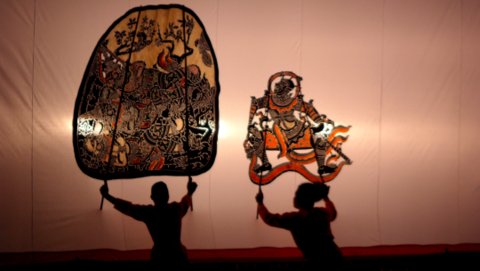
Nang Yai The movement of these performers is backed by traditional musical instruments and a narrator. This shadow play is believed to be as old as 700 years when it was first performed in the mid-1300s during the Ayutthaya era. Nang Yai is an off-shoot of Nang Talung, in which smaller figures are used. Nang Talung is believed to have started in the southern Thai province of Phattalung, hence the name talung. It’s popular in the southern provinces where the narrative is in the southern dialect. However the shadow drama is performed in several places in SE Asia and its origins can’t be definitely ascertained. Some of the places where this drama is performed are; Java, Bali in Indonesia (wayang purwa), Malaysia (wayang kulit)*, Cambodia, Laos and Thailand. *Note: The wayang kulit in Malaysia is fiurther sub-divided into three categories according to geographic location, wayang jawa, wayang melayu and wayang siam. Nang Yai differs from Nang Talung in a number of ways;
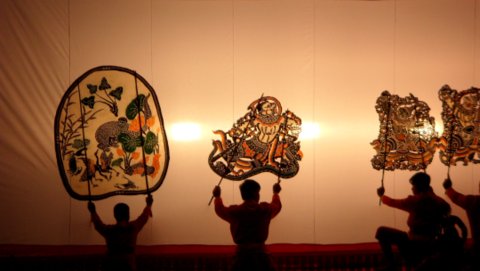
The intricate figures carved on the hides The Nang Yai shadow drama encompasses several art forms;
Table of contents Making Nang Yai Making the elaborate figures in the Nang Yai play is a painstaking process. The hide of young oxen is bleached and cleaned to get rid of hairs and tissue. Then it’s soaked in the juice of the lamphong tree, lemon grass, pineapple and orange, darkened by rubbing it with burnt coconut husk. Only after the hide has been carefully prepared can the carving commence. Carving is done with a set of chisels of various sizes, scissors, hammers and various other tools. After carving, the figures are painted in various colours. Table of contents Performing Nang Yai We arrived at 10 am on a Saturday morning, just in time for the Nang Yai display in the hall located at one end of Wat Khanon. The hall was filled with spectators and the display had already started when we entered the hall. 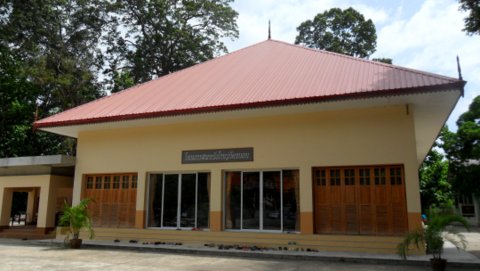
The hall where performances are given The Nang Yai performance was by a troupe that is trained in Wat Khanon. This is one of two places in Thailand where the art is kept alive by continuously training young people. As the art is very difficult to master, there is real danger that it will fade away if no conscious effort is made to conserve it. 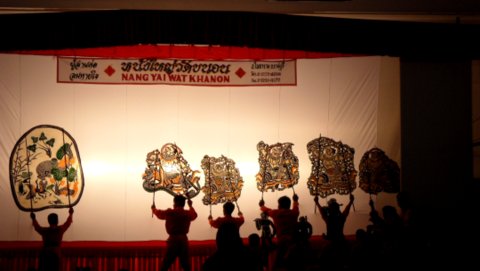
Nang Yai display The other place where Nang Yai is conserved is Wat Sawang Arom in Singburi where there’s a museum as well as Nang Yai performances. Here’s a short video clip of the Nang Yai performance that morning. If the video doesn’t appear please click on this link Table of contents Nang Yai Museum The Nang Yai Museum is in a traditional Thai house in the grounds of Wat Khanon. The temple has played a very important role in the conservation of the art of Nang Yai. 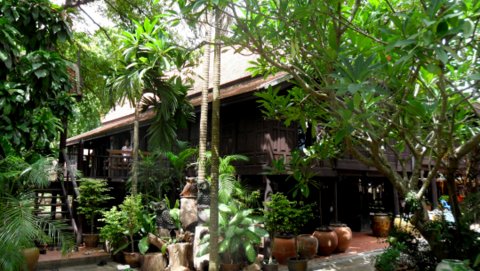
Nang Yai Museum, Wat Khanon From 1989 to 1995, 313 old Nang Yai figures have been duplicated; the old ones are retained as exhibits in the museum and the new ones used for performances. Many of the cow hides used in this project were donated by the villagers in the area. 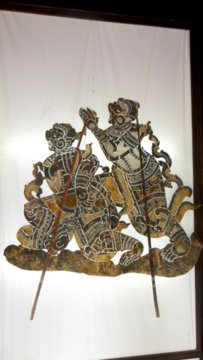
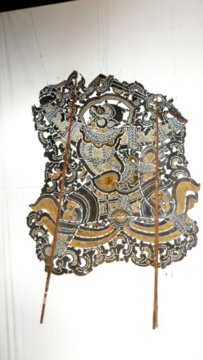
Nang Yai exhibits The exhibits within depict some of the characters in the Ramayana epic. The Ramayana tells the story of Prince Rama who was banished to the live in the forest with his wife Sita. Ravana, the evil King of Lanka kidnaps Sita. Prince Rama with the help of Hanuman and his army of monkeys build a causeway to Lanka to rescue Sita and Ravana is defeated. Sita is reunited with Prince Rama and they return to the kingdom of Ayodhya. This event is celebrated by Divali, the Festival of Lights, when good triumphs over evil. 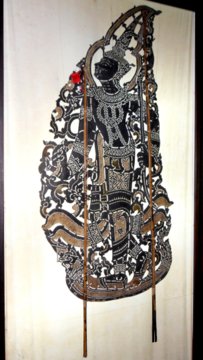
Phra Rama or Prince Rama 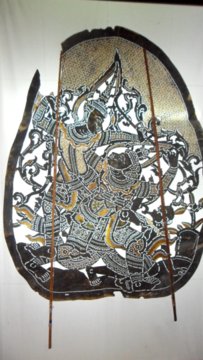
Phra Rama fights with Totsagan 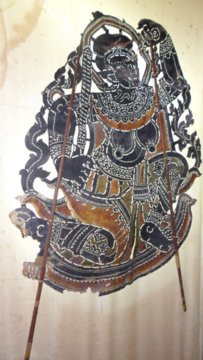
The Ogress of the Ocean who guards the seas around Langka against intruders 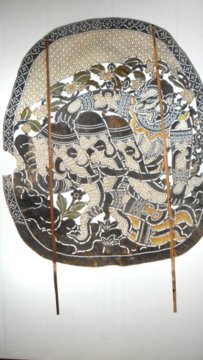
Hanuman tears off Erawan’s head Here’s a sample of an actual Nang Yai figure that’s kept in the store. 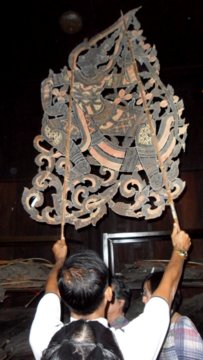
The real thing Unfortunately some of the exhibits are already showing signs of wear and tear. In 2007, Wat Khanon was awarded an UNESCO award for preserving intangible cultural heritage, a well-deserved reward in these modern times when traditional practices are fast disappearing. Table of contents Map to the Nang Yai Museum View Nang Yai Museum in a larger map Address Nang Yai Museum Wat Khanom Tambon Soifa Amphoe Photharam Ratchaburi Opening hours Every day from 0800 – 1700 hours The Nang Yai display is every Saturday at 1000 – 1100 hours Admission to the Nang Yai display is free. Visitors are encouraged to make donations to support the Nang Yai troupe. Admission to the Nang Yai Museum is also free. Any donations received will go towards defraying the costs of lunch for the children at the Wat Khanon School. Please remove your footwear before entering the display hall and the museum. How to get to there By car From Bangkok, get on to Phetkasem Road (highway 4), go all the way past Nakhon Pathom city. The road will turn south and run parallel to the Mae Klong River. Turn right to highway 3080, cross the railway track, then the bridge across the Mae Klong. Turn right and proceed all the way till you get to Wat Khanon. Table of contents My thanks My sincere thanks to Pattaraporn Charoensuk for showing me around the cultural treasures of her home province. Table of contents For hotels in Ratchaburi
If you enjoyed reading this e-zine, please forward it to a friend. If you received this from a friend and found it interesting, please subscribe at Bangkok Travelbug. What do you think of the Bangkok Travelbug? We love to hear from you What other subscribers have said Till next month then. Eric Lim Tour Bangkok Legacies Find us on Facebook Copyright@2008-2014 Tour Bangkok Legacies All rights reserved |
| Back to Back Issues Page |
